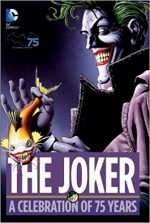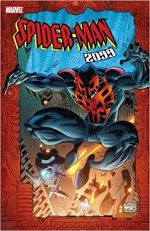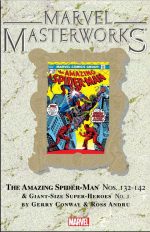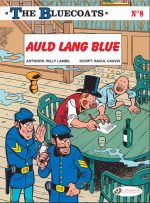
By Bob Kane, Bill Finger, Jerry Robinson and many & various (DC Comics)
ISBN: 978-1-4012-4759-1
When the very concept of high priced graphic novels was just being shelf-tested way back in in the late 1980s, DC Comics produced a line of glorious full-colour hardback compilations spotlighting star characters and celebrating standout stories decade by decade from the company’s illustrious and varied history.
They then branched out into themed collections which shaped the output of the industry to this day; such as a fabulous congregation of yarns which offer equal billing and star status to one of the most enduring arch-foes in fiction: The Maestro of Malignant Mirth known only as The Joker.
So much a mirror of and paralleling the evolution of the epochal Batman, the exploits of the Joker are preceded here by a brief critical analysis of the significant stages in the villain’s development, beginning with the years 1940-1942 and Part I: The Grim Jester.
After deconstruction comes sinister action as debut appearance ‘Batman Vs. The Joker’ (by Bill Finger & Bob Kane from Batman #1, Spring 1940) provides suspenseful entertainment whilst introducing the most diabolical member of the Dark Knight’s rogues’ gallery. A chilling moody tale of brazen extortion and wilful wanton murder begins when an eerie character publicly announces that he will kill certain business and civic figures at specific times…
An instant hit, the malignant murdering Joker kept coming back. ‘The Riddle of the Missing Card’ (Finger, Kane & Jerry Robinson, Batman #5 1941) once again saw the Crime Clown pursue loot and slaughter, but this time with a gang of card-themed crooks at his side. It did not end well for the whimsical butcher…
Fame secured, the Devil’s Jester quickly became an over-exposed victim of his own nefarious success. In story terms that meant seeking to “reform†and start over with a clean slate. Turning himself in, the maniac grasses on many criminal confederates but ‘The Joker Walks the Last Mile’ (Finger, Kane & Robinson, Detective Comics #64 June 1942) soon shows that tousled viridian head twisting inexorably back towards murderous larceny…
As years passed and tastes changed, the Laughing Killer mellowed into a bizarrely baroque bandit and Part II: The Clown Prince assesses that alteration, before providing fascinating examples beginning with ‘Knights of Knavery’ from Batman #25 (1944 by Don Cameron, Jack Burnley & Robinson).
Here he and arch-rival The Penguin fractiously join forces to steal the world’s biggest emerald and outwit all opposition, before falling foul of their own mistrust and arrogance once the Caped Crusaders put their own thinking caps on.
‘Rackety-Rax Racket’ Batman #32 (1945 by Cameron & Dick Sprang) is another malevolently marvellous exploit which sees the ideas-starved Prankster of Peril finding felonious inspiration in college-student hazing and initiation stunts, after which ‘The Man Behind the Red Hood’ (Detective Comics #168, February 1951) reveals a partial origin as part of a brilliantly engrossing mystery by Finger, Lew Sayre Schwartz & Win Mortimer, which all began when the Caped Crusader regales eager young criminology students with the story of “the one who got awayâ€â€¦ just before the fiend suddenly came back…
In ‘The Joker’s Millions’ (Detective Comics #180, February1952) pulp sci fi writer David Vern Reed, Sprang & Charles Paris provide a gloriously engaging saga disclosing how the villain’s greatest crime rival took revenge from the grave by leaving the Harlequin of Hate too rich to commit capers.
It was all a vindictive double-barrelled scheme though, making the Joker a patsy and twice a fool as the Caped Crusaders eventually find to their great amusement…
Then from World’s Finest Comics #61 (November 1952) Reed, Kane, Schwartz & Paris perpetrate ‘The Crimes of Batman’ as Robin is taken hostage and the Gotham Gangbuster is compelled to commit a string of felonies to preserve the lad’s life. Or so the Joker vainly hopes…
‘Batman – Clown of Crime’ (Batman #85, August 1954 by Reed, Sheldon Moldoff & Paris) captures the dichotomy of reason versus chaos as the eternal arch enemies’ minds are swapped in a scientific accident. Soon a law-abiding Joker and baffled Robin are hunting down a madcap loon with the ultimate weapon at his disposal, the secret of the Gotham Guardian’s true identity
The Silver Age of comicbooks utterly revolutionised a flagging medium, bringing a modicum of sophistication to the returning sub-genre of masked mystery men. However, for quite some time the changes instigated by Julius Schwartz in Showcase #4 – which rippled out to affect all National/DC Comics’ superhero characters – generally passed Batman and Robin by.
Fans buying Batman, Detective Comics, World’s Finest Comics and even Justice League of America would read adventures that in look and tone were largely unchanged from the safely anodyne fantasies that had turned the grim Dark Knight into a mystery-solving, alien-fighting costumed Boy Scout as the 1940s turned into the1950s.
By the end of 1963, Schwartz – having either personally or by example revived and revitalised much of DC’s line and by extension the entire industry with his modernizations – was asked to work his magic with the creatively stalled and nigh-moribund Caped Crusaders just as they were being readied for mainstream global stardom.
‘The Joker’s Jury’ (Batman #163 May 1963) by Finger, Moldoff & Paris was the last sight of the Clown before his numerous appearances on the blockbuster Batman TV show warped the villain and left him unusable for years…
Here, however, Robin and his mentor are trapped in the criminal enclave of Jokerville, where every citizen is a fugitive bad-guy dressed up as the Clown Prince and where all lawmen are outlaws…
The story of the how the Joker was redeemed as a metaphor for terror and evil is covered in Part III: The Harlequin of Hate and thereafter confirmed by the single story which undid all that typecasting damage.
‘The Joker’s Five-Way Revenge’ (Batman #251 September 1973 by Dennis O’Neil & Neal Adams) reversed the zany, “camp†image by re-branding the characters and returning to the original 1930s concept of a grim and driven Dark Avenger chasing an insane avatar of pure evil.
Such a hero needs far deadlier villains and, by reinstating the psychotic, diabolically unpredictable Killer Clown who scared the short pants off the readers of the Golden Age, set the bar high. A true milestone that utterly redefined the Joker for the modern age: the frantic saga sees the Mirthful Maniac stalking his old gang, determined to eradicate them all with the hard-pressed Gotham Guardian desperately playing catch-up. As the crooks die in all manner of Byzantine and bizarre ways, Batman realises his arch-foe has gone irrevocably off the deep end.
Terrifying and beautiful, for many fans this is the definitive Batman/Joker story.
The main contender for that prize follows. ‘The Laughing Fish/The Sign of the Joker’ appeared in Detective Comics #475-476 (February and April 1978) concluding a breathtaking signature run of retro tales by Steve Englehart, Marshall Rogers & Terry Austin
The absolute zenith in a short but stellar sequence resurrecting old foes naturally starred the Dark Knight’s nemesis at his most chaotic; beginning with ‘The Laughing Fish’ before culminating in ‘The Sign of the Joker!’, comprising one of the most reprinted Bat-tales ever concocted and even adapted as an episode of the award-winning Batman: The Animated Adventures TV show in the 1990s.
In fact, you’ve probably already read it. But if you haven’t… what a treat you have awaiting you!
As fish with the Joker’s horrific smile began turning up in sea-catches all over the Eastern Seaboard, the Clown Prince attempts to trademark them. When patent officials foolishly tell him it can’t be done, they start dying… publicly, impossibly and incredibly painfully…
The story then culminated in a spectacular apocalyptic clash which shaped, informed and redefined the Batman mythos for decades to come…
Although Crisis on Infinite Earths transformed the entire DC Universe it left the Joker largely unchanged, however it did narratively set the clock back far enough to present fresher versions of most characters.
‘To Laugh and Die in Metropolis’ comes from Superman volume 2 #9 (September1987) wherein John Byrne & Karl Kesel reveal how the Malicious Mountebank challenges the Man of Steel for the first time. The result is a captivating but bloody battle of wits, with the hero’s friends and acquaintances all in the killer clown’s crosshairs…
The next (frustratingly incomplete) snippet comes from one of the most effective publicity stunts in DC’s history.
Despite decades of wanting to be “taken seriously†by the wider world, every so often a comicbook event gets away from editors and publishers and takes on a life of its own. This usually does not end well for our beloved art form, as the way the greater world views the comics microcosm is seldom how we insiders and cognoscenti see it.
One of the most controversial sagas of the last century saw an intriguing marketing stunt go spectacularly off the rails – for all the wrong reasons – and become instantly notorious whilst sadly masking the real merits of the piece.
‘A Death in the Family’ Chapter Four originated in Batman #427 (December 1988), concocted by Jim Starlin, Jim Aparo & Mike DeCarlo and needs a bit more background than usual…
Robin, the Boy Wonder debuted in Detective Comics#38 (April 1940) created by Bob Kane, Bill Finger & Jerry Robinson. He was a juvenile circus acrobat whose parents were murdered by a mob boss. The story of how Batman took the orphaned Dick Grayson under his scalloped wing and trained him to fight crime has been told, retold and revised many times over the decades and still undergoes the odd tweaking to this day
The child Grayson fought beside Batman until 1970 when, as a sign of the turbulent times, he flew the nest, becoming a Teen Wonder and college student. His invention as a junior hero for younger readers to identify with had inspired an incomprehensible number of costumed sidekicks and kid crusaders, and Grayson continued in similar vein for the older, more worldly-wise readership of America’s increasingly rebellious youth culture.
During the 1980s the young hero led the New Teen Titans, re-established a turbulent working relationship with Batman and reinvented himself as Nightwing. This of course left the post of Robin open…
After Grayson’s departure Batman worked alone until he caught a streetwise young urchin trying to steal the Batmobile’s tires. Debuting in Batman#357 (March 1983) this lost boy was Jason Todd, and eventually the little thug became the second Boy Wonder (#368, February 1984), with a short but stellar career, marred by his impetuosity and tragic links to one of the Caped Crusader’s most unpredictable foes…
Todd had some serious emotional problems which became increasingly apparent in the issues leading up to ‘A Death in the Family’ story arc. As the street kid became more callous and brutal in response to the daily horrors he was exposed to he deliberately caused the death of a vicious drug-dealer with diplomatic immunity. Jason then began a guilty spiral culminating in the story-arc which comprised Batman#426-429.
Ever more violent and seemingly incapable of rudimentary caution, Jason is suspended by Batman. Meanwhile the Joker is returns, but rather than his usual killing frenzy, the Clown Prince is after mere cash, because the financial disaster of “Reaganomics†has depleted his coffers – meaning he can’t afford his outrageous murder gimmicks…
Without purpose, Jason has been wandering the streets where he grew up. Encountering a friend of his dead mother, he learns a shocking secret. The woman who raised him was not his birth-mother, and there exists a box of personal papers indicating three different women who might be his true mother.
Lost and emotionally volatile Jason sets out to track them down…
After monumental efforts, he locates Dr. Sheila Haywood working as a famine relief worker in Ethiopia. As Jason heads for the Middle East and a confrontation with destiny, he is unaware that Batman is also in that troubled region, hot on the Joker’s trail since the Maniac of Mirth is attempting to sell stolen nuclear weapons to any terrorist who can pay…
When Jason finds his mother, he has no idea that she has been blackmailed into a deadly scam involving stolen relief supplies by the Clown Prince of Crime…
I’m not going to bother with the details of the voting fiasco that plagues all references to this tale as it’s all copiously detailed elsewhere, but suffice to say that to test then-new marketing tools a 1-900 number was established and, thanks to an advanced press campaign, readers were offered the chance to vote on whether Robin would live or die in the story.
Against every editorial expectation vox populi voted thumbs down and Jason died in a most savage and uncompromising manner….
The kid had increasingly become a poor fit in the series and this storyline galvanised a new direction with a darker, more driven Batman, beginning almost immediately as the Joker, after killing Jason in a chilling and unforgettably violent manner, became UN ambassador for Iran (later revised as the fully fictional Qurac – just in case…) and at the request of the Ayatollah himself attempted to kill the entire UN General Assembly during his inaugural speech…
And here is the true injustice surrounding this tale: the death of Robin (who didn’t even stay dead) and the media uproar over the voting debacle took away from the real importance of this story – and perhaps deflected some real scrutiny and controversy. Starlin had crafted a clever and bold tale of real world politics and genuine issues which most readers didn’t even notice.
Terrorism Training Camps, Rogue States, African famines, black marketeering, Relief fraud, Economic, Race and Class warfare, Diplomatic skullduggery and nuclear smuggling all featured heavily, as did such notable hot-button topics as Ayatollah Khomeini, Reagan’s Cruise Missile program, the Iran-Contra and Arms for Hostages scandals and the horrors of Ethiopian refugee camps. Most importantly it signaled a new and fearfully casual approach to violence and death in comics-books.
The story selected to represent the lad here is a poor choice, however. This is not to say that ‘A Death in the Family’ is a lesser tale: far from it, and Starlin, Aparo & DeCarlo’s landmark, controversial story of the murder of brash, bright Jason Todd by the Joker shook the industry and still stands the test of time.
However, all that’s included here is the final chapter, and even I, having read it many times, was bewildered as to what was going on.
If you want to see the entire saga – and trust me, you do – seek out a copy of the complete A Death in the Family…
In 1989 Batman broke box office records in the first of a series of big budget action movies. The Joker was the villain du jour and stole the show. That increased public awareness again influenced the comics and is covered in Part IV: Archnemesis before ‘Going Sane’ Part Two ‘Swimming Lessons’ provides a fresh look at the motivations behind the maniacal madness.
The story comes from Batman: Legends of the Dark Knight #66 (December 1994) LoDK began in the frenzied atmosphere following the movie. With planet Earth completely Bat-crazy for the second time in 25 years, DC wisely supplemented the Gotham Guardian’s regular stable of titles with a new one specifically designed to focus on and redefine his early days and cases through succession of retuned, retold classic stories.
Three years earlier the publisher had boldly begun retconning their entire ponderous continuity via the landmark maxi-series Crisis on Infinite Earths; rejecting the concept of a vast multiverse and re-knitting time so that there had only ever been one Earth.
For new readers, this solitary DC world provided a perfect place to jump on at a notional starting point: a planet literally festooned with iconic heroes and villains draped in a clear and cogent backstory that was now fresh and newly unfolding.
Many of their greatest properties were graced with a reboot, all enjoying the tacit conceit that the characters had been around for years and the readership were simply tuning in on just another working day.
Batman’s popularity was at an intoxicating peak and, as DC was still in the throes of re-jigging narrative continuity, his latest title presented multi-part epics reconfiguring established villains and classic stories: infilling the new history of the re-imagined, post-Crisis hero and his entourage.
An old adage says that you can judge a person by the calibre of their enemies, and that’s never been more ably demonstrated than in the case of Batman and The Joker. The epic battles between these so similar yet utterly antithetical icons have filled many pages and always will…
With that in mind, 4-part psychological study ‘Going Sane’ by J.M. DeMatteis, Joe Staton & Steve Mitchell takes us back to a time when Batman was still learning his job and had only crossed swords with the Clown Prince of Crime twice before…
After a murderously macabre circus-themed killing-spree in the idyllic neighbourhood of Park Ridge and abduction of crusading Gotham Councilwoman Elizabeth Kenner, a far-too-emotionally invested Batman furiously plays catch-up. This leads to a disastrous one-sided battle in front of GCPD’s Bat signal and a frantic pursuit into the dark woods beyond the city.
Driven to a pinnacle of outrage, the neophyte manhunter falls into the Joker’s devilishly prepared trap and is caught in an horrific explosion. His shattered body is then dumped in the by an incredulous, unbelieving killer clown reeling in shock at his utterly unexpected ultimate triumph…
Stand-alone extract ‘Swimming Lessons’ opens here with Batman missing and Police Captain James Gordon taking flak from all sides for not finding the Predatory Punchinello or the savage mystery assailant who recently murdered an infamous underworld plastic surgeon…
Under Wayne Manor faithful manservant Alfred fears the very worst whilst in a cheap part of town thoroughly decent nonentity Joseph Kerr suffers terrifying nightmares of murder and madness.
His solitary days end when he bumps into mousy spinster Rebecca Brown. Days pass and the two lonely outcasts find love in their mutual isolation and a shared affection for classic slapstick comedy. The only shadows blighting this unlikely romance are poor Joe’s continual nightmares and occasional outbursts of barely suppressed rage…
As days turn to weeks and then months, Alfred sorrowfully accepts the situation and prepares to close the Batcave forever. As he descends, however, he is astounded to see the Dark Knight has returned…
The story of Joe Kerr – fictive product of a deranged mind which simply couldn’t face life without Batman – is another yarn readers will want to experience in full, but that too will only happen in a different collection…
The World’s Greatest Detective continues to relentlessly battle the Clown Prince in ‘Fool’s Errand’ (Detective Comics #726, October 1998) as Chuck Dixon & Brian Stelfreeze depict a vicious mind-game conducted by the Hateful Harlequin from his cell, using a little girl as bait and an army of criminals as his weapon against the Dark Knight after which ‘Endgame’ Part Three ‘…Sleep in Heavenly Peace’ (Detective Comics #741 February 2000 by Greg Rucka, Devin Grayson, Damian Scott, Dale Eaglesham, Sean Parsons, Sal Buscema & Rob Hunter) sees the Joker plaguing a Gotham City struggling to recover from a cataclysmic earthquake.
It’s Christmas but the stubborn survivors are so stretched striving to stop The Joker’s plan to butcher all the babies left in town they are unable to notice that his real scheme will gouge a far more personal wound in their hearts…
‘Slayride’ by Paul Dini, Don Kramer & Wayne Faucher (Detective Comics #826 February 2007 and another Seasonal special) is one of the best Joker – and definitely the best Robin – stories in decades. This Christmas horror story sees our Crazed Clown trap third Boy Wonder Tim Drake in a stolen car, making him an unwilling participant in a spree of vehicular homicides amongst the last-minute shoppers.
If there is ever a Greatest Batman Christmas Stories Ever Told collection (and if there’s anybody out there with the power to make it so, get weaving please!), this just has to be the closing chapter….
Brining us up to date Part V: Rebirth focuses on the 2011 New 52 continuity-wide reboot and an even grimmer, Darker Knight who debuted in Detective Comics volume 2 #1 with what might be assumed to be the last Joker story. As crafted by Tony Daniel & Ryan Winn, ‘Faces of Death’ follows the mass-murdering malcontent on another pointless murder spree which culminates in his apparent death, leaving behind only his freshly skinned-off face nailed bloodily to an asylum wall…
A year later the Joker explosively returned, mercilessly targeting all of Batman’s allies in a company-wide crossover event dubbed Death of the Family. The crippling mind-games and brutal assaults culminated in ‘But Here’s the Kicker’ (Batman #15, February 2013 by Scott Snyder, Greg Capullo & Jonathan Glapion) and purportedly the final battle between Bat and Clown: but we’ve all heard that before, haven’t we…?
The Joker has the rare distinction of being arguably the most iconic villain in comics and can claim that title in whatever era you choose to concentrate on; Noir-esque Golden Age, sanitised Silver Age or malignant modern and Post-Modern milieus. This book captures just a fraction of all those superb stories…
Including pertinent covers by Sayre Swartz & Roussos, Mortimer, Moldoff, Adams, Rogers & Austin, Byrne, Mike Mignola, Staton & Mitchell, Stelfreeze, Alex Maleev & Bill Sienkiewicz, Simone Bianchi, Daniel & Winn and Capullo, this monolithic testament to the inestimable value of a good bad-guy is a true delight for fans of all ages and vintage.
© 1940, 1941, 1942, 1944, 1945, 1951, 1952, 1954, 1964, 1973, 1978, 1987, 1988, 1994, 1998, 2000, 2007, 2011, 2012, 2014 DC Comics. All Rights Reserved.












